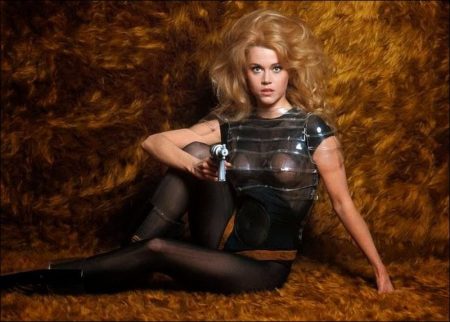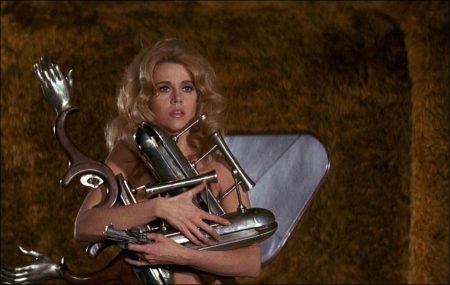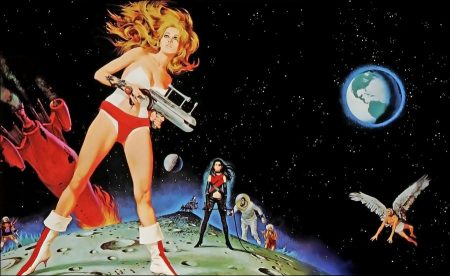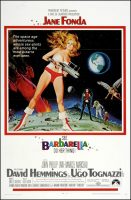Taglines: Who can save the universe?
Barbarella movie storyline. The year is AC 40,000. The pure beauty Barbarella, who loves to show off her body by swinging in zero gravity and free love, undertakes a difficult task as the planet’s representative in space: finding a crazy genius named Duran Duran, who threatens peace in the universe with a new invention. ‘alien races, faces the danger. He even has the chance to make love on the wings of a handsome and blind angel.
Barbarella is a sci-fi film directed by Roger Vadim in 1968. It is based on the French comic book Barbarella. In the film, Jane Fonda portrays Barbarella, a representative of the United World government in the 41th century, sent to find the scientist Durand Durand, who can end humanity with positive rays.
Producer Dino De Laurentiis bought the rights to make Barbarella a film. Vadim took on the role of director as if he were a comic book fan and wanted to adapt the film. Before he divorced his wife Jane Fonda, Vadim tried to propose to several actresses, including Virna Lisi, Brigitte Bardot and Sophia Loren. Vadim asked his friend Terry Southern to write the script; This scenario was changed drastically during filming, and some other authors were involved.
The film became particularly popular when it was released in the UK as the second-highest-grossing film of the year following The Jungle Book. Today’s film critics praise the visuals and cinematography of the film, but after the first few scenes they find the film’s story weak. Since the release of the sequels, several attempts have been planned to restructure and other adaptations, but none of them have been produced.

Film Review for Barbarella
When we think of the comic book adaptations that have become very popular nowadays, we see that repetition of each other is done despite all the storms. It is possible to say that these fantastic worlds, where the heroes and the evils have changed, with plenty of visual references for the audience, are confined to certain patterns and not very much separated from the similar scenario. The lack of almost gray characters reinforces this similarity (especially to the extent that the existential efforts of the heroes, who were “fashion sonra after Nolan’s Batman adaptation, are also satisfactory).
Despite all the fanfare and visual impressiveness, it should be said clearly; it is not possible for these adaptations to correspond with the stripless gravity of Jane Fonda in Barbarella’s opening scene. Adapted from Roger Vadim’s French cartoonist Jean-Claude Forest’s comic book series in the 60s, Barbarella brings intense eroticism to the screen with an absurdly kitsch aesthetic in an extraordinarily fantastic world. In the meantime, he manages to speak in a wide range from sexual freedom to world peace, disarmament, pop-art and even fashion.
Duran Duran, a scientist who knows the secret of ozit Positronic Ray kaybol, disappears in the 41st century when disarmament is ensured in the universe and life in peace continues. In the face of this situation that threatens the peaceful life in the universe, Barbarella’s task is to find the scientist and prevent the beam from reaching the wrong person. Our hero, who did not get in trouble during his journey, does not hesitate to use his body to thank his saviors.
Naive fantasies, erotic connotations and futuristic designs wandering the frontier of pornography are the main factors that brought Barbarella to cult status. Kitsch creates the tone of visuality, obvious shamelessness and excess, and uses it to attack sexuality, conservatism, which is seen as taboo. To put it a bit, we can say that Barbarella is moving in a delicate balance where she places naked men in a huge lantern and presents ‘men’s essence, uses an‘ orgasm machine benzer similar to church organs, hosts queens seeking pleasure in dream chambers and, in any case, remains naked.
Another point that brought the film to cult status is the cheapness of event flow and dialogues parallel to the visual structure. It is obvious that Barbarella is not a hero, more like a hero than a pestilent girl who gets into trouble, who wants hysterical help and shares her beauty with the whole universe. In this respect, it also demolishes the image of the powerful protagonist in comic book adaptations. On the other hand, the freedom of the woman to exhibit her body and to make love to whom she wants; it insists on the fact that the body is not embarrassing and desire is not a feeling to hide. All the deconstructive moves he uses to provoke general perception are hidden behind an inexpensive excess mask.
A Cult Revolt
Barbarella ‘68 is one of the comic strip and cinema counterparts of the liberation efforts of the generation. It is possible to find the discourse of the generation that never ceases to limit themselves, denies all existing powers and shouts ma fighting, making love içerisinde in the absurd story of the film.
Barbarella is a tribute to flower children, from asking the question, “Why would a man want to discover guns? It is important that women find the destruction of all war discourse and that women are glorified by the angel at the end of the film. It is also not overlooked that all scenes contain LSD connotations. Barbarella is an extraordinary beauty to be shown in different variations.
Camp travels in the world of Barbarella, a blend of sexuality, evocative of sex in every situation, as the film says: “It’s always better to do things like before.
1) Take me to the heights, Teach me to fly; Excite with bright lights. (From the opening song of Barbarella; Barbarella, The Glitterhouse)
2) The famous British New Wave music group is named Duran Duran from the film’s bad character. There are also numerous references to cult film.
Barbarella (1968)
Directed by: Roger Vadim
Starring: Jane Fonda, John Phillip Law, Anita Pallenberg, Milo O’Shea, Marcel Marceau, Claude Dauphin, Véronique Vendell, Giancarlo Cobelli, Serge Marquand, Marie Therese Chevallier
Screenplay by: Jean-Claude Forest, Terry Southern
Production Design by: Mario Garbuglia
Cinematography by: Claude Renoir
Film Editing by: Victoria Mercanton
Costume Design by: Jacques Fonteray, Paco Rabanne
Music by: Bob Crewe, Charles Fox
MPAA Rating: None.
Distributed by: Paramount Pictures
Release Date: October 10, 1968
Visits: 361


